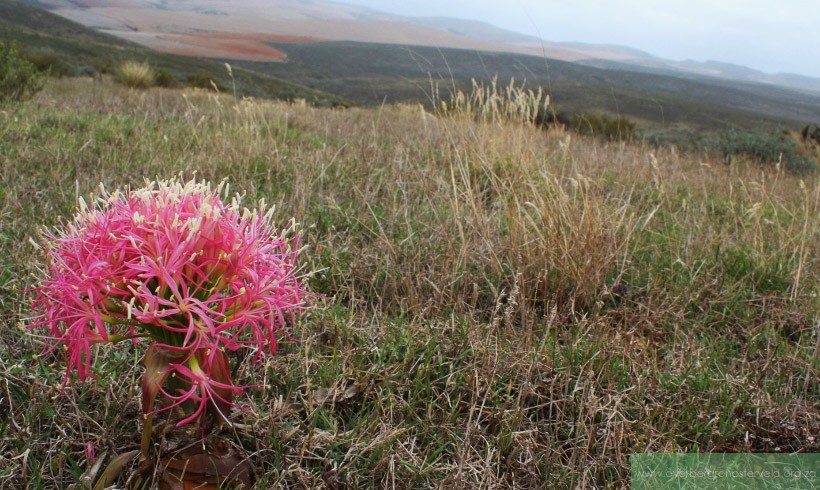Autumn has arrived in the Overberg. The nights are drawing in and becoming cooler and planting season is well underway for the farmers. The renosterveld seems dry and brown at this time of year, awaiting the coming of the winter rain. It seems that there is little to be seen in the veld at this time of year, but a closer inspection reveals some of the beautiful flowering bulbs that are to be found, bringing colour to the dry autumn landscape.

First up is Haemanthus sanguineus, more commonly known as the paintbrush lily or April Fool, after its most common flowering time. It flowers most often after fire, producing its bright red flowers first from a bulb the size of a tennis ball before the leaves emerge later during the season. They are found at seasonally moist sites on rocky areas, sandy plains and slopes in a wide variety of habitats.
The genus Haemanthus is endemic to Southern Africa in Namibia, South Africa, Lesotho and Swaziland and comprises a total of 22 species. Haemanthus bulbs were some of the first plants to be collected from the Cape by Dutch colonists and were cultivated in the Netherlands as early as the 17th Century. However, despite becoming known as the ‘Cape Tulip’ they failed to gain any popularity in cultivation.
Despite the highly toxic nature of the bulb, Haemanthus sanguineus has a variety of different medicinal uses. Early records report its use for treating ulcers and also in the treatment of asthma. An extract from the bulb was also traditionally used as a diuretic.

Another common sight in autumn at seasonally moist sites is Amaryllis belladonna. This species also flowers most profusely after fire. The name means ‘beautiful lady’ but this bulb is also known as the naked lady owing to the growth of the inflorescence at the head of a bare stalk. The flowers are most strongly scented in the evening, attracting moths as pollinators, but during the day they are commonly visited by Carpenter bees.

One of the largest and most spectacular of all the autumn bulbs is Brunsvigia orientalis. The bright red inflorescence which emerges prior to the leaves can reach as much as 40cm in diameter. The genus Brunsvigia was named by Heister in 1753 in honour of the Duke of Brunswick.

This year we have been treated to the sight of Boophone disticha flowering at Haarwegskloof Renosterveld reserve. These large geophytes from the Amaryllidaceae family do not flower annually and can take as long as ten years to flower from seed and so it is a precious sight to treasure. The flowers are pollinated by bees and flies but also are sometimes visited by ants. The bulb is highly poisonous and the name Boophone is derived from the Greek words ‘Bous’ meaning ox and ‘phone’ meaning death. It is known to be poisonous to sheep and cattle.
Boophone disticha has a variety of different medicinal uses. The Khoi San traditionally used the poison from the bulbs for the tips of their arrows. The outer covering of the bulb has been used to treat boils and abscesses. This species has a wide distribution throughout South Africa and as far north as Uganda. However, it is declining in its natural habitat owing to a combination of habitat loss and collection for muthi or traditional medicine. Within South Africa trade is thought to amount to as much as 1.6 tonnes annually.

Also flowering on the reserve is Nerine humilis. This is a relatively common autumn bulb in the Overberg’s renosterveld vegetation but there are several unusual forms. At Haarwegskloof Renosterveld Reserve we have a very special form with a particularly long reproductive parts (stamens and styles). This is thought to be an adaptation to a specific pollinator but more research is needed to find out what insect this may be. For now it remains a mystery……

